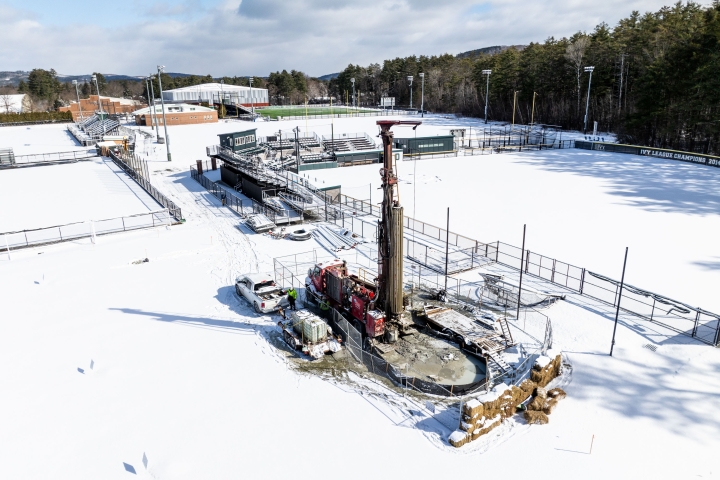This fall, Dartmouth plans to reach a major milestone in the $500 million decarbonization project underway on campus: the installation of the first geo-exchange borefield.
Following testing done in the Athletics District over the winter, plans are being finalized to construct Dartmouth’s first borefield under Chase Field #4, the southernmost field in the athletic complex that is used as a practice field by the women’s and men’s soccer teams. Testing concluded that Chase was suitable for a borefield, which effectively uses the subsurface of the Earth as a thermal battery for buildings.
Installation of the borefield will follow work taking place this summer to install piping and electrical duct banks in multiple locations on campus that will eventually connect to a geo-exchange heat pump plant that will also be connected to the borefields.
The system is part of President Sian Leah Beilock’s commitment to address climate change and sustainability on campus and beyond. In April, she announced the Dartmouth Climate Collaborative, which includes the decarbonization project that will change how the campus is heated, cooled, and powered, by reducing energy consumption, constructing highly efficient new buildings, and transitioning to low-carbon energy sources.
The addition of an expanded geo-exchange system to the campus energy technology portfolio will help meet Dartmouth’s energy needs without generating fossil fuel emissions.
“I’m excited we are preparing for this next stage of our decarbonization work,” says Josh Keniston, senior vice president for capital planning and campus operations. “Athletic fields are perfect for this technology. The process of drilling wells is disruptive, but once wells are completed, the fields are restored to their previous use.”
Geo-exchange systems, which use a closed-loop network of fluid-filled pipes in boreholes to harness the Earth’s ambient temperature (consistently about 50 degrees Fahrenheit), are effective in regions that have significant seasonal temperature changes. The boreholes are drilled roughly 800 feet into the Earth’s surface and work in tandem with a pump to cool buildings in summer and warm buildings in winter. This system is also known commonly as “ground source heat pumps.”

Dartmouth Decarbonization further explains the technology and work associated with building a geo-exchange system. The site provides a project timeline and outlines steps that Dartmouth is taking to reach carbon zero by 2050.
Dartmouth’s transition to low-carbon energy will require construction in nearly every part of campus in the coming decade as outdated, oil-fueled heating systems are replaced with efficient, decarbonized ones and transition the campus from using steam to hot-water heating, a key driver of improved efficiency. This process will enable Dartmouth to reach the goals of reducing campus emissions by 60% by 2030 and 100% by 2050.
Chase—the athletic field east of South Park Street—will be the first area of campus to host borefields, and the Athletics District will likely be home to the heat pump plant. Mike Harrity, the Haldeman Family Director of Athletics and Recreation, said athletics is ready to lead the way on climate action.
“While construction under and around our fields and facilities is a significant short-term inconvenience for some of our varsity programs, we embrace athletics’ role in supporting President’s Beilock’s bold vision to address climate change and sustainability,” he says. “At Dartmouth, we welcome our opponents to ‘The Woods,’ and part of our obligation as the stewards of this special place is to care for it. Our students learn to work together to tackle challenges on and off the field, keeping their eyes on the goal even when it means short-term sacrifice, and we are excited to help lead the way on climate action.”
During construction in the Athletics District, Dartmouth will mitigate the disruption, which will include noise-control measures, traffic control, and the management of excess water generated during the drilling process. The district is expected to host more than one borefield. Dartmouth is working on sequencing which borefield will be constructed next. Overall, hundreds of wells are expected to be drilled in the district over the next two to four years.
Depending on future design and engineering findings, some sports will need to practice at Garipay Field, as their practice areas are disturbed. Garipay is located at the North End of campus on Lyme Road.
Work planned this fall includes:
- Geo-exchange borefield: Drilling on Chase is expected to begin in late October and last for approximately six months, after which the field will be reconstructed and anticipated to be ready for use a year from now.
- Distribution piping: Continued work to install piping, currently happening in the East Wheelock Street area. Once connected to a heat pump plant, the piping will move water for heating and cooling around campus.
- Heat pump plant: To use the energy from the borefields, Dartmouth must construct pumps to move water—and the heating and cooling energy of that water—to where it is needed. The pumps will be in a building likely located in the Athletics District. The building will include space to learn about decarbonization.
Over the summer, the Dartmouth Sustainability Office plans to host a community forum, following one co-hosted with Sustainable Hanover in March 2024, to explain Dartmouth’s decarbonization plan and the current and future work on the system. In addition, a meeting with neighbors of the Athletics District has been scheduled for 7 p.m. on Aug. 14. A location for the meeting will be announced later this summer.
Construction schedules, updates, and maps of the affected areas can be found on the Campus Services website.
Updates are provided as work progresses, and Vox Daily and social media posts will regularly highlight impacts on pedestrians, cyclists, and motorists, as well as other issues, such as temporary changes to some entryways to buildings.


